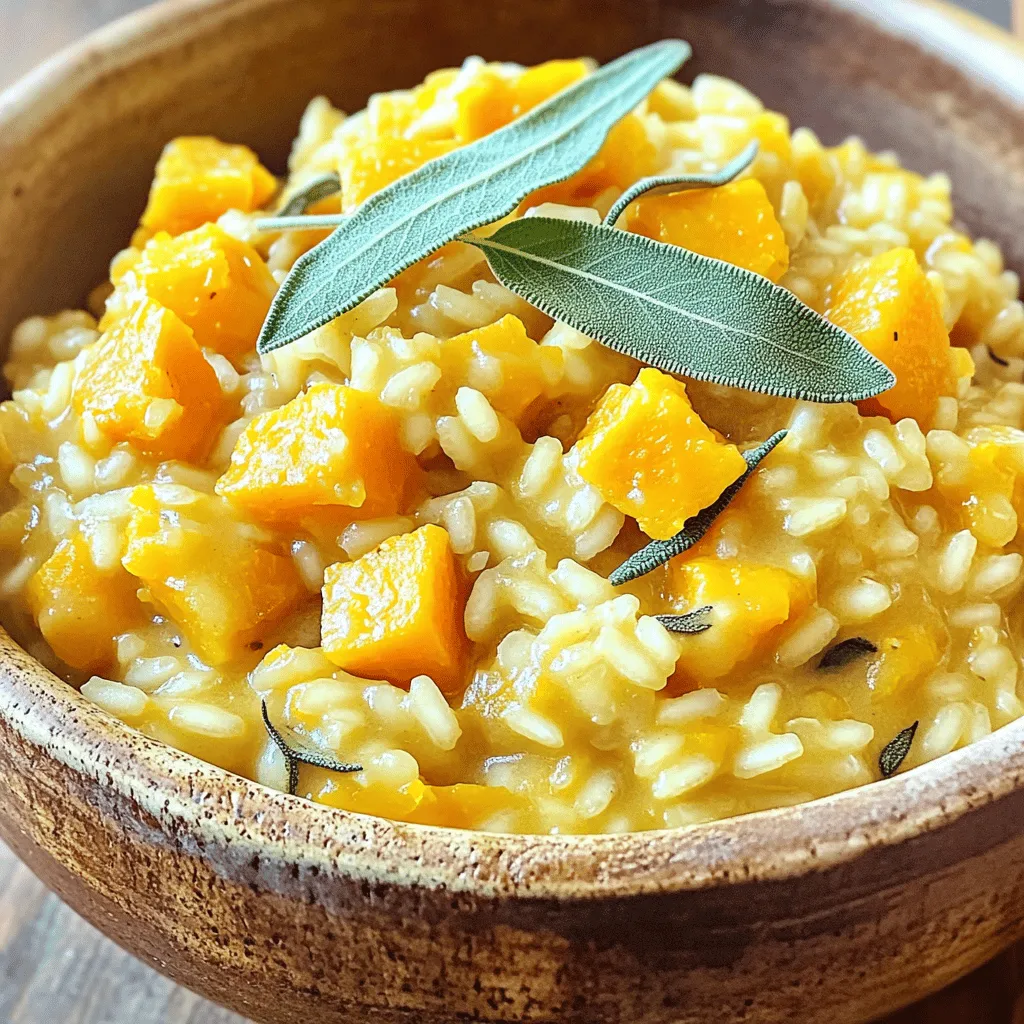Craving a warm bowl of creamy comfort? Look no further than my Butternut Squash Sage Risotto! This dish blends velvety Arborio rice with sweet butternut squash and fragrant sage for an unforgettable meal. Whether you’re new to cooking or an experienced chef, I’ll guide you through each step. Get ready to impress your taste buds and warm your heart with this perfect fall dish! Let’s dive into the delicious details!
Ingredients
List of Main Ingredients
– 1 medium butternut squash, peeled and diced
– 1 cup Arborio rice
– 4 cups vegetable broth
– 1 small onion, finely chopped
– 2 cloves garlic, minced
– 1 tablespoon fresh sage, chopped (or 1 teaspoon dried)
– 1 tablespoon olive oil
– 1 tablespoon unsalted butter
– ½ cup grated Parmesan cheese (or nutritional yeast for a vegan option)
– Salt and pepper to taste
– Fresh sage leaves for garnish
Butternut squash makes this risotto sweet and creamy. Arborio rice gives it that perfect texture. Vegetable broth adds depth. Onion and garlic create a great base flavor. Fresh sage brings a warm, earthy note. Olive oil and butter keep things rich and smooth. Parmesan cheese enhances creaminess, while salt and pepper round out the taste. You can also use nutritional yeast as a vegan option.
Ingredient Substitutions
– Vegan alternatives: Use nutritional yeast instead of Parmesan cheese. Omit the butter or replace it with more olive oil.
– Gluten-free options: This recipe is already gluten-free, but always check your broth.
– Seasonal variations: Try using pumpkin or sweet potatoes instead of butternut squash in fall. Add peas or spinach in spring for a fresh touch.
These substitutions let you adjust the dish to meet your needs and taste preferences.
Step-by-Step Instructions
Preparation Before Cooking
– Preparing the butternut squash: Start by peeling and dicing your butternut squash into small cubes. This helps it cook faster and blend well with the rice. Aim for about 1-inch pieces for even cooking.
– Chopping onions and garlic: Next, finely chop one small onion and mince two cloves of garlic. These will add great flavor to your risotto.
– Heating the vegetable broth: In a medium saucepan, heat 4 cups of vegetable broth over low heat. Keeping it warm helps the rice cook evenly.
Cooking Process
– Sautéing onion and garlic: In a large skillet, pour in 1 tablespoon of olive oil and heat it over medium heat. Add the chopped onion and cook for about 5 minutes. Stir until the onion turns translucent. Then, add the minced garlic and cook for another minute until it smells great.
– Incorporating butternut squash and sage: Now, stir in the diced butternut squash and 1 tablespoon of fresh chopped sage. Cook this mixture for about 5 to 7 minutes. You want the squash to start softening.
– Adding Arborio rice and broth gradually: Add 1 cup of Arborio rice to the skillet. Stir it well to coat the rice with the oil and mix it with the squash. Cook for 2 to 3 minutes. The rice will become slightly translucent. Then, start adding the warm vegetable broth one ladle at a time. Keep stirring until the rice absorbs the liquid. Repeat this until the rice is creamy and just tender, about 18 to 20 minutes.
Finishing Touches
– Mixing in butter and Parmesan: Once the rice is cooked to your liking, take it off the heat. Stir in 1 tablespoon of unsalted butter and ½ cup of grated Parmesan cheese. Mix until everything is melted and creamy.
– Seasoning to taste: Taste your risotto and add salt and pepper as needed. This step brings out all the flavors.
– Letting risotto rest before serving: Let your risotto sit for a few minutes to thicken up. This resting time helps meld the flavors together and makes it even more delicious.
Tips & Tricks
Achieving Creamy Risotto
To make the best risotto, you must stir. Stirring helps release the starch from the rice. This starch makes the risotto creamy. If you do not stir, the rice may stick and not cook evenly.
Using warm broth is also key. Adding cold broth stops the cooking process. Keep the broth on low heat while you cook. This way, you maintain a steady temperature. It leads to a perfect creamy risotto every time.
Cooking time is important too. Risotto takes about 18-20 minutes to cook. You want the rice to be al dente, which means it should have a slight bite. Test the rice near the end of cooking to see if it’s ready.
Flavor Enhancements
Adding white wine boosts flavor. Use a dry white wine after cooking the onion and garlic. This step adds depth to your risotto. The alcohol cooks off, leaving a rich taste.
Incorporating herbs and spices can change the dish. Try thyme or rosemary for a twist. A hint of nutmeg can also add warmth to your risotto. Experiment to find your favorite combination.
For a richer taste, mix in some cream or extra butter. You can also use a bit more Parmesan cheese. These ingredients enhance the creaminess and flavor. Enjoy playing around with different flavors!

Variations
Vegetarian and Vegan Options
You can make this risotto vegetarian by using vegetable broth. For a vegan twist, swap the Parmesan cheese for nutritional yeast. Nutritional yeast gives a nice cheesy flavor without any dairy. You can also add more vegetables like spinach or mushrooms. These veggies add color and flavor, making your dish even tastier.
Different Grain Substitutions
If you want to try different grains, consider quinoa or barley. Quinoa cooks faster and has a nice nutty taste. Barley adds a chewy texture to your dish. When cooking these grains, use the same method as for Arborio rice. Just adjust the liquid and cooking time based on the grain you choose.
Seasonal Additions
Using seasonal vegetables makes this dish even better. In fall, add some roasted Brussels sprouts or carrots. In spring, you might include peas or asparagus. Adjust the flavors based on the season. For instance, you can use lemon zest in spring for a fresh taste. This keeps your risotto exciting all year round!
Storage Info
Storing Leftovers
To store your butternut squash sage risotto, follow these steps for best results:
– Let the risotto cool down to room temperature.
– Place it in an airtight container.
– Refrigerate it for up to three days.
This method keeps the risotto fresh and tasty. If you want to keep it longer, freezing is a great option.
Reheating Tips
When it’s time to enjoy leftovers, here are my top tips for reheating risotto:
– Use a stovetop method for the best texture.
– Add a splash of vegetable broth or water to keep it moist.
– Heat it over low to medium heat, stirring gently.
This helps to revive the creamy texture and rich flavor.
Freezing Options
You can freeze butternut squash sage risotto for later. Here’s how to do it properly:
– Cool the risotto completely first.
– Scoop portions into freezer-safe bags or containers.
– Label them with the date before placing them in the freezer.
To thaw, move the risotto to the fridge overnight. Reheat it using the stovetop method I mentioned earlier. This way, you can enjoy that creamy comfort food even weeks later!
FAQs
What is the best type of rice for risotto?
The best rice for risotto is Arborio rice. This rice has a high starch content. It gives risotto its creamy texture. Other good options include Carnaroli and Vialone Nano. These types also create a rich and creamy dish. They absorb broth well and cook evenly.
Can butternut squash risotto be made ahead of time?
Yes, you can make butternut squash risotto ahead of time. Cook it and let it cool. Then, store it in an airtight container. This way, you can keep it in the fridge for up to three days. When ready to eat, reheat it on the stove. Add a splash of broth to bring back its creamy texture.
How do I make risotto without stirring continuously?
You can make risotto with less stirring by using the oven. Preheat your oven to 375°F (190°C). Cook the onion and garlic on the stove. Then, add the rice and broth to an oven-safe pot. Cover it and transfer it to the oven. Cook for 25 minutes, stirring once halfway through. This method gives you creamy risotto with less effort.
In this blog post, we explored how to make a delicious butternut squash risotto. We covered the key ingredients, alternative options, and easy cooking steps. Tips for achieving a creamy texture and flavor enhancements were also shared. You can customize your risotto with seasonal additions and various grains. Remember, storing leftovers correctly ensures they taste great later. I hope you feel ready to try this dish and enjoy every bite! Happy cooking!


